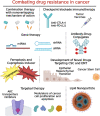Understanding and targeting resistance mechanisms in cancer
- PMID: 37229486
- PMCID: PMC10203373
- DOI: 10.1002/mco2.265
Understanding and targeting resistance mechanisms in cancer
Abstract
Resistance to cancer therapies has been a commonly observed phenomenon in clinical practice, which is one of the major causes of treatment failure and poor patient survival. The reduced responsiveness of cancer cells is a multifaceted phenomenon that can arise from genetic, epigenetic, and microenvironmental factors. Various mechanisms have been discovered and extensively studied, including drug inactivation, reduced intracellular drug accumulation by reduced uptake or increased efflux, drug target alteration, activation of compensatory pathways for cell survival, regulation of DNA repair and cell death, tumor plasticity, and the regulation from tumor microenvironments (TMEs). To overcome cancer resistance, a variety of strategies have been proposed, which are designed to enhance the effectiveness of cancer treatment or reduce drug resistance. These include identifying biomarkers that can predict drug response and resistance, identifying new targets, developing new targeted drugs, combination therapies targeting multiple signaling pathways, and modulating the TME. The present article focuses on the different mechanisms of drug resistance in cancer and the corresponding tackling approaches with recent updates. Perspectives on polytherapy targeting multiple resistance mechanisms, novel nanoparticle delivery systems, and advanced drug design tools for overcoming resistance are also reviewed.
Keywords: cancer therapy; combination therapy; drug resistance; resensitization.
© 2023 The Authors. MedComm published by Sichuan International Medical Exchange & Promotion Association (SCIMEA) and John Wiley & Sons Australia, Ltd.
Conflict of interest statement
The authors declare no conflict of interest. Author Zhe‐Sheng Chen is the Editorial Board Member of MedComm. Author Zhe‐Sheng Chen was not involved in the journal's review of, or decisions related to, this manuscript.
Figures




References
-
- Bray F, Laversanne M, Weiderpass E, Soerjomataram I. The ever‐increasing importance of cancer as a leading cause of premature death worldwide. Cancer. 2021;127(16):3029‐3030. - PubMed
-
- Sung H, Ferlay J, Siegel RL, et al. Global cancer statistics 2020: GLOBOCAN estimates of incidence and mortality worldwide for 36 cancers in 185 countries. CA Cancer J Clin. 2021;71(3):209‐249. - PubMed
-
- Kareliotis G, Tremi I, Kaitatzi M, et al. Combined radiation strategies for novel and enhanced cancer treatment. Int J Radiat Biol. 2020;96(9):1087‐1103. - PubMed
Publication types
LinkOut - more resources
Full Text Sources
